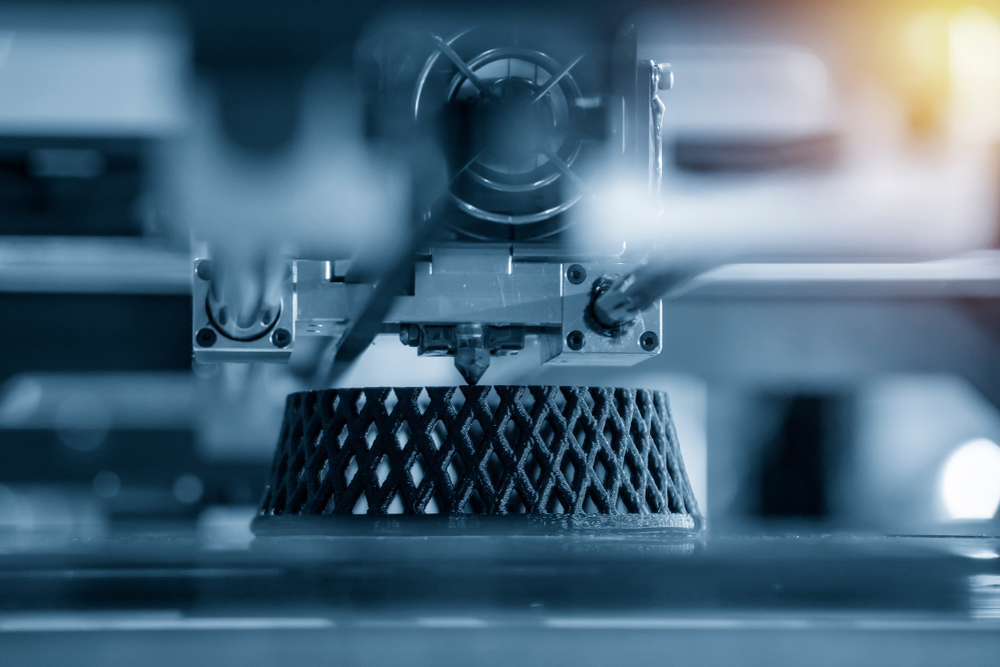Additive manufacturing creates a solid object by successively adding material in layers using a 3D printing solution. A 3D printer creates parts based on 3D CAD models by depositing material, selectively melting and fusing powder, or curing photopolymers. The additive process uses only the necessary material amounts, significantly reducing waste by-products, even if support structures are required. Depending on the 3D printing technology, the parts may require significant to minimal post-processing.
Additive manufacturing is often associated with low-volume production or prototyping. Some 3D printers are developed for the sole purpose of rapid prototyping. Still, innovations in 3D printing technology have made high-volume production both feasible and often the best solution for accelerating a new product to market. 3D printing has no tooling costs and very few design limitations. Companies can implement 3D printing solutions from innovation through production, eliminating certain drawbacks associated with traditional manufacturing.

From Design to Prototype: An Optimized Process
An additive manufacturing process begins with initial concept sketches. 3D CAD models are developed from the sketches to create a prototype for testing. Companies use prototypes to quickly get market feedback, confirming aesthetics, weight, dimensional accuracy, and functionality. With 3D printing, companies can print multiple functional and aesthetic prototype variations at the same time with production-ready materials. Expanding the number of prototyping designs evaluated before going to production increases the final product’s market success.
- Aesthetic Prototyping: Companies fine-tune multiple design iterations to evaluate visual characteristics like shape, texture, color, and size dimensions before arriving at a final design. On a single 3D printer, numerous designs can be produced simultaneously and tested for optimal fit and finish.
- Functional Prototyping: Functional prototypes are printed with production-ready materials and function just like the end product. Field testing can begin immediately to determine the effectiveness of different mechanical properties. For example, a footwear manufacturer testing a shoe or insole might add a lattice structure to reduce weight or stiffen an area by increasing density, thickening bars, or increasing the number of nodes. Multiple iterations can be tested in parallel without creating new tooling, and the highest-performing model goes into production.
3D printers take in-series processes and make them parallel so companies can then bring a part from sketch to production-ready in as little as three weeks.
Prototyping to Production: The Ideal Additive Manufacturing Process
Once a company finishes the prototyping stage and a final design is approved, it is ready for production. If a prototype was developed in a smart factory with an additive manufacturing process that supports production-grade materials and scale, it could immediately go into production. 3D printing lowers the barrier for companies to leverage production processes and materials during prototyping, entering the market with new products faster than with conventional processes.
Companies that partner with a smart factory achieve several production benefits:
- Expanded Inventory Control: Traditional manufacturing facilities generally require minimum order quantities (MOQs) that are higher than necessary, leading to oversized inventories. Storage space is needed to accommodate the inventory, and in the case of a recall or possible product redesign, additional parts can become obsolete. Smart factories don’t require high MOQs, reducing storage costs.
- Agile Market Responses: Additive manufacturing enables companies to have a virtual inventory, with all part information stored in the cloud. Orders can be placed and created with greater agility to meet additional market demand.
- Redesign Flexibility: Market feedback sometimes dictates redesigning of parts for optimal usage. Conventional production methods require retooling in addition to redesigns, limiting quick responsiveness. With 3D printing solutions, designers make the design adjustments in the software, send the new CAD file to the smart factory, and order a new product shipment.
- Worldwide factory locations: Smart factories are located worldwide, so manufacturers incorporate locations into their operation that best meets their needs. Some manufacturers will combine 3D printed parts with traditionally manufactured parts, especially in the footwear industry. A smart factory could be located next to the facility where final assembly occurs, allowing workers to easily combine 3D-printed and traditionally-produced shoe parts to create the final product.
3D Printers Can Improve Your Operation
There are numerous benefits in taking a product from sketch to production with a 3D printing solution. Additive manufacturing technology accelerates the prototyping phase, minimizes waste, gives companies greater control over inventory, and makes them more agile to meet changing market demand. For companies that use traditional manufacturing methods in their operation, there are many benefits of implementing 3D printers in select areas of the production process. Many organizations have proven successful in using 3D printing technology to streamline prototyping and create low-volume runs before transitioning to high-volume injection molding.
Whether you are interested in pursuing an entirely 3D printer-based manufacturing process or looking to optimize parts of the existing framework, additive manufacturing can benefit your organization. LuxCreo offers 3D printing solutions for low and high-volume production in many industries.
To learn more about the ideal additive manufacturing process and how to accelerate products from concept to production, visit our contact page or call (650) 336-0888.
